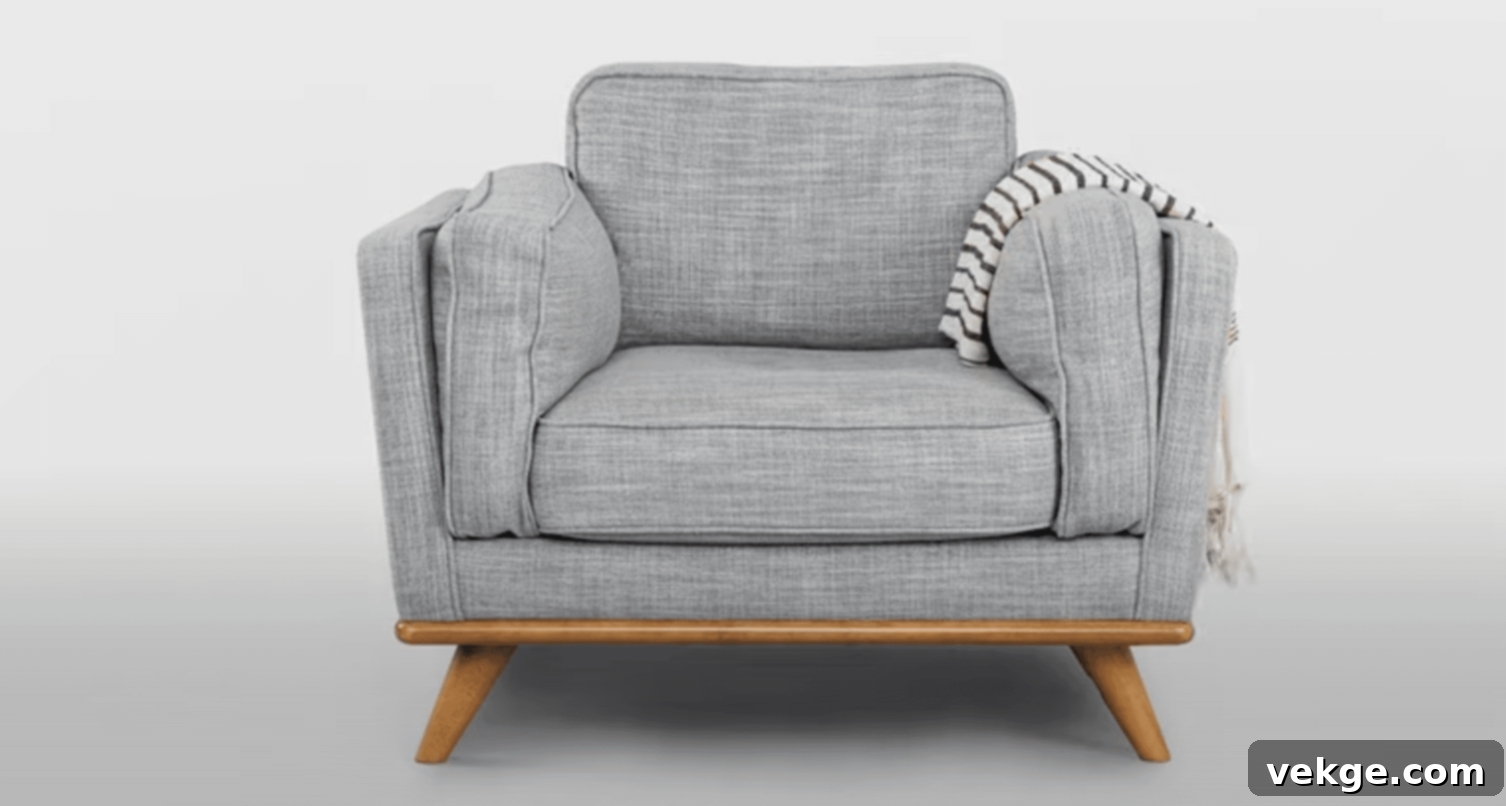Deep Clean Your Fabric Couch at Home: A Comprehensive DIY Guide for Stain and Odor Removal
Is your beloved fabric couch showing signs of wear, looking tired, dingy, or perhaps harboring some unwelcome odors? You are certainly not alone in this common household dilemma. Many homeowners grapple with the challenge of maintaining a clean and fresh sofa, which often serves as the heart of their living space. Regular and effective cleaning is not just about aesthetics; it’s a crucial step that not only significantly prolongs your couch’s life but also contributes to a healthier and more hygienic living environment for you and your family.
Tackling stubborn stains, lingering odors, and the accumulation of everyday dirt and grime might seem like a daunting task, but there’s no need to worry. This comprehensive guide is meticulously designed to walk you through the entire process of deep cleaning your fabric couch right in the comfort of your own home. By following our expert advice, you’ll not only save money on professional cleaning services but also gain invaluable skills. We’ll cover everything from correctly identifying your fabric type and understanding its specific care needs to implementing effective techniques for removing even the toughest stains and thoroughly deodorizing your upholstery. You’ll learn how to leverage simple tools and common household items to achieve professional-level results. By the time you finish this guide, you’ll be fully equipped with the knowledge and confidence to tackle even the dirtiest couches, giving your cherished furniture a remarkable new lease on life.
Preparing for Your Fabric Couch Deep Clean
Successful and effective couch cleaning begins long before any cleaning solution touches your upholstery. Proper preparation is absolutely essential for achieving excellent results and preventing potential damage. This section will guide you through all the vital steps you need to take to get ready before you start the actual cleaning process, ensuring a smooth and successful experience.
1. Check Manufacturer’s Instructions (Care Tag Codes)
Before you even think about applying any cleaning product or method, your very first step should always be to locate and thoroughly read the care instructions provided by your couch’s manufacturer. These instructions, typically found on a small tag attached to a cushion or underneath the couch, are your definitive guide. They will explicitly tell you which cleaning methods and products are safe and appropriate for your specific fabric type and which ones to strictly avoid.
- W (Water-based cleaner): This code means you can safely use water-based cleaning solutions, like mild soap and water.
- S (Solvent-based cleaner): For these fabrics, only use water-free solvents. Water can cause stains, shrinkage, or damage.
- WS (Water or Solvent): These versatile fabrics can tolerate either water-based or solvent-based cleaners.
- X (Professional cleaning only): This code indicates that you should only vacuum the fabric and absolutely never use any liquid cleaner, as it could cause damage. For deeper cleaning, professional services are recommended.
2. Gather Necessary Cleaning Tools and Supplies
Having all your tools and supplies organized and within reach will make the cleaning process much more efficient and less stressful. Here’s a list of what you’ll typically need:
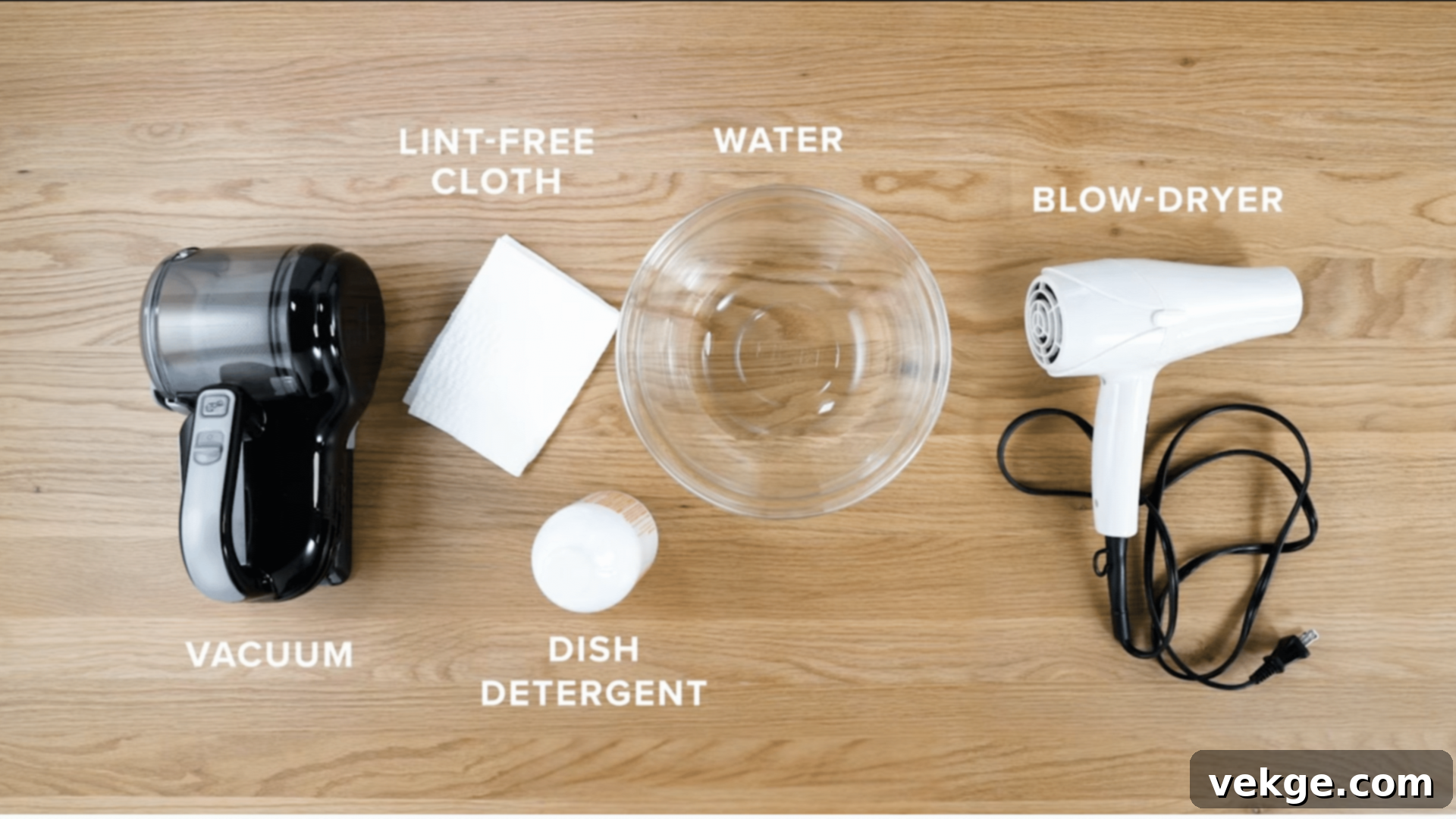
- A vacuum cleaner with a soft brush attachment: Essential for removing loose dirt, dust, and crumbs without harming the fabric.
- Soft, lint-free cloths: You’ll need several clean cloths for blotting, applying solutions, and drying. Microfiber cloths are ideal.
- Mild dish detergent: A small amount mixed with water is a gentle yet effective cleaning solution for many fabric types. Choose a clear, dye-free option.
- Clean water: For mixing solutions and rinsing. Distilled water is preferred to avoid mineral deposits.
- A spray bottle: Handy for applying cleaning solutions evenly and sparingly.
- A blow dryer (optional, on cool setting): Useful for speeding up drying time in small areas, but air drying is generally preferred for the whole couch.
- Baking soda: A natural and effective deodorizer.
- White vinegar: Good for tough stains and odors, especially pet-related ones (ensure compatibility with fabric).
- Rubber gloves: To protect your hands from cleaning solutions.
- Small bucket or bowl: For mixing solutions.
3. Remove Cushions and Debris
Before any serious cleaning begins, you need to clear the deck. This initial step is vital for uncovering hidden dirt and ensuring a truly comprehensive clean.
- Carefully remove all cushions that you can. Set them aside for individual cleaning.
- Reach into all crevices and under the cushions to remove larger debris like crumbs, pet toys, coins, or anything else that might have fallen in. A vacuum crevice tool is excellent for this.
- Give the cushions a good shake or a quick pat outside to dislodge surface dust before moving them.
4. Vacuum the Entire Couch Thoroughly
This pre-vacuuming stage is crucial for removing loose dirt and dust that, if left behind, could turn into mud when wet, making stains worse. It also primes the fabric for deeper cleaning.
- Attach the soft brush attachment to your vacuum cleaner. This attachment is gentle on upholstery and effectively lifts surface debris.
- Systematically go over the entire couch, including the back, arms, and especially the seams and small spaces where dust and crumbs tend to accumulate.
- Don’t forget to vacuum both sides of the removable cushions thoroughly.
- This step is not just about getting rid of visible dust and crumbs; it’s about preparing the fabric for the next stages of cleaning. Ensure every area is free from loose particulate matter before you start any wet cleaning.
5. Test a Small, Inconspicuous Area
This is arguably the most critical preparatory step. Skipping it can lead to irreversible damage.
- Before applying any cleaning product or solution to a visible part of your couch, always perform a patch test. Choose a small, hidden area—such as the back of a cushion, an underside flap, or a discrete corner.
- Apply a tiny amount of your chosen cleaning solution (whether it’s dish soap and water, vinegar solution, or a commercial cleaner) to this test spot.
- Gently dab it with a clean white cloth. Wait for a few minutes (and up to an hour) to see if there’s any adverse reaction.
- Look for discoloration, fading, fabric shrinkage, water spots, or any other negative effects. If the test spot looks good, you can proceed with confidence to the rest of the couch. If not, try a different method or consult a professional.
By diligently following these preparatory steps, you’ll be well-prepared for a thorough, safe, and highly effective cleaning of your fabric couch, setting the stage for a truly refreshed piece of furniture.
Step-by-Step Guide to Deep Cleaning a Fabric Couch
Once your couch is prepped, it’s time to dive into the deep cleaning process. Follow these detailed steps to give your fabric couch a thorough, revitalizing clean that tackles dirt, grime, and common stains.
Step 1: Vacuum the Couch (Revisited)
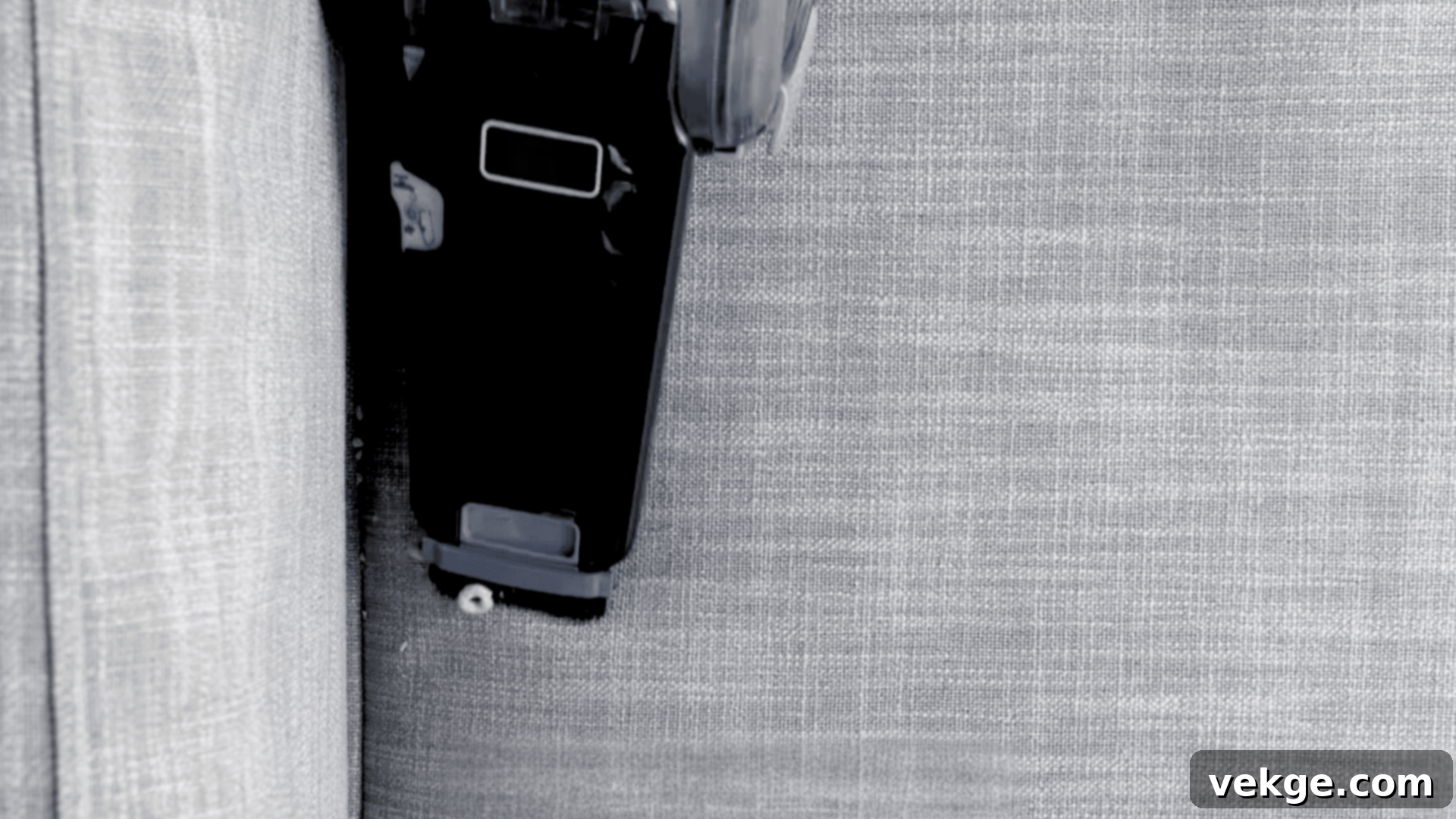
While you performed a preliminary vacuum during preparation, a second, more focused pass ensures maximum dust and debris removal, which is crucial before introducing any moisture.
- Re-attach your vacuum’s soft brush attachment or upholstery tool.
- Begin at the highest points of the couch (the top of the backrest) and systematically work your way downwards. This ensures any loosened dirt falls to areas you haven’t cleaned yet.
- Pay meticulous attention to seams, piping, crevices, and corners. Use a crevice tool for these tight spots where dust, crumbs, and pet hair love to accumulate.
- Remove all cushions again and vacuum both sides of each cushion thoroughly, ensuring you get into the corners.
- Don’t forget to vacuum the entire frame underneath the cushions. You’d be surprised how much debris hides there. A powerful vacuuming job now will make subsequent steps much easier and more effective.
Step 2: Spot Clean Stains Effectively
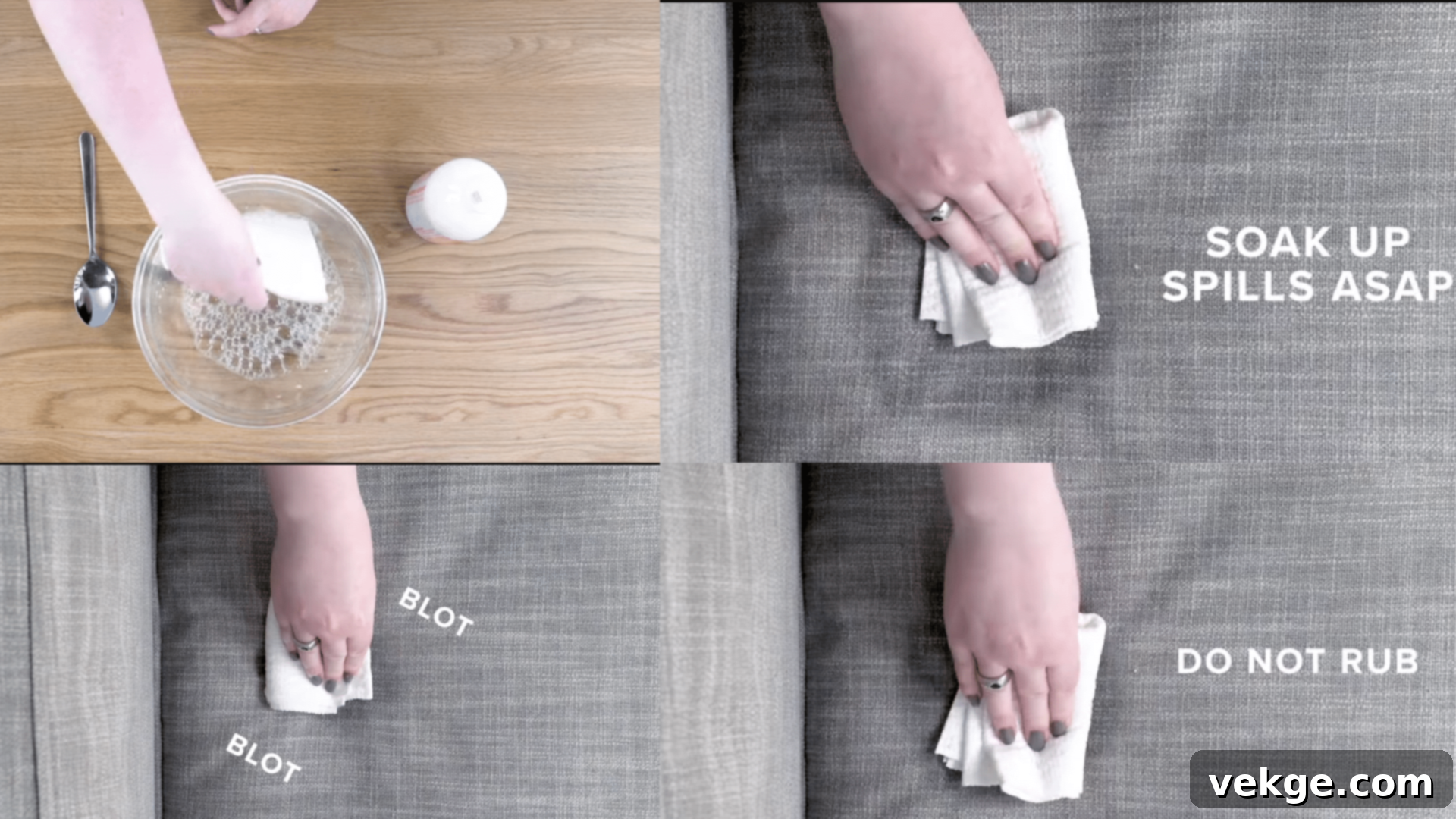
Addressing individual stains before a general cleaning is key. This prevents them from spreading or setting deeper into the fabric during the overall cleaning process.
- Visually inspect your entire couch to identify all visible stains. Note their location and, if possible, their origin (e.g., food, pet, ink).
- For fresh spills: Act immediately! Blot (do NOT rub) the spill with a clean, dry, white cloth or paper towel to absorb as much liquid as possible. Rubbing can push the stain deeper into the fabric fibers and spread it further.
- Prepare your cleaning solution: For most water-safe fabrics (W or WS code), mix a small amount (about a teaspoon) of mild, clear dish soap with about two cups of warm water in a bowl until it becomes sudsy. You want to use the suds, not the watery solution itself.
- Apply the suds: Dip a clean, lint-free white cloth into just the suds, ensuring the cloth is damp but not saturated.
- Gently dab the stain: With the sudsy cloth, gently dab the stain. Always work from the outside edge of the stain towards its center. This technique prevents the stain from spreading outwards and creating a larger mark.
- Rinse and repeat: After dabbing the stain, rinse your cloth with clean water (make sure it’s just damp) and gently dab the area again to remove any soap residue. Repeat steps 5 and 6 until the stain lifts or is significantly faded. Be patient; some stubborn stains might require several applications.
- For specific stains:
- Grease stains: After blotting excess, sprinkle a little cornstarch or baking soda on the stain, let it sit for 15-30 minutes to absorb the grease, then vacuum it up before applying the soap solution.
- Pet stains: A solution of equal parts white vinegar and water can be very effective at neutralizing odors and breaking down pet-related stains. Blot thoroughly, then apply the vinegar solution, and finally blot dry.
Step 3: Dry the Couch Thoroughly
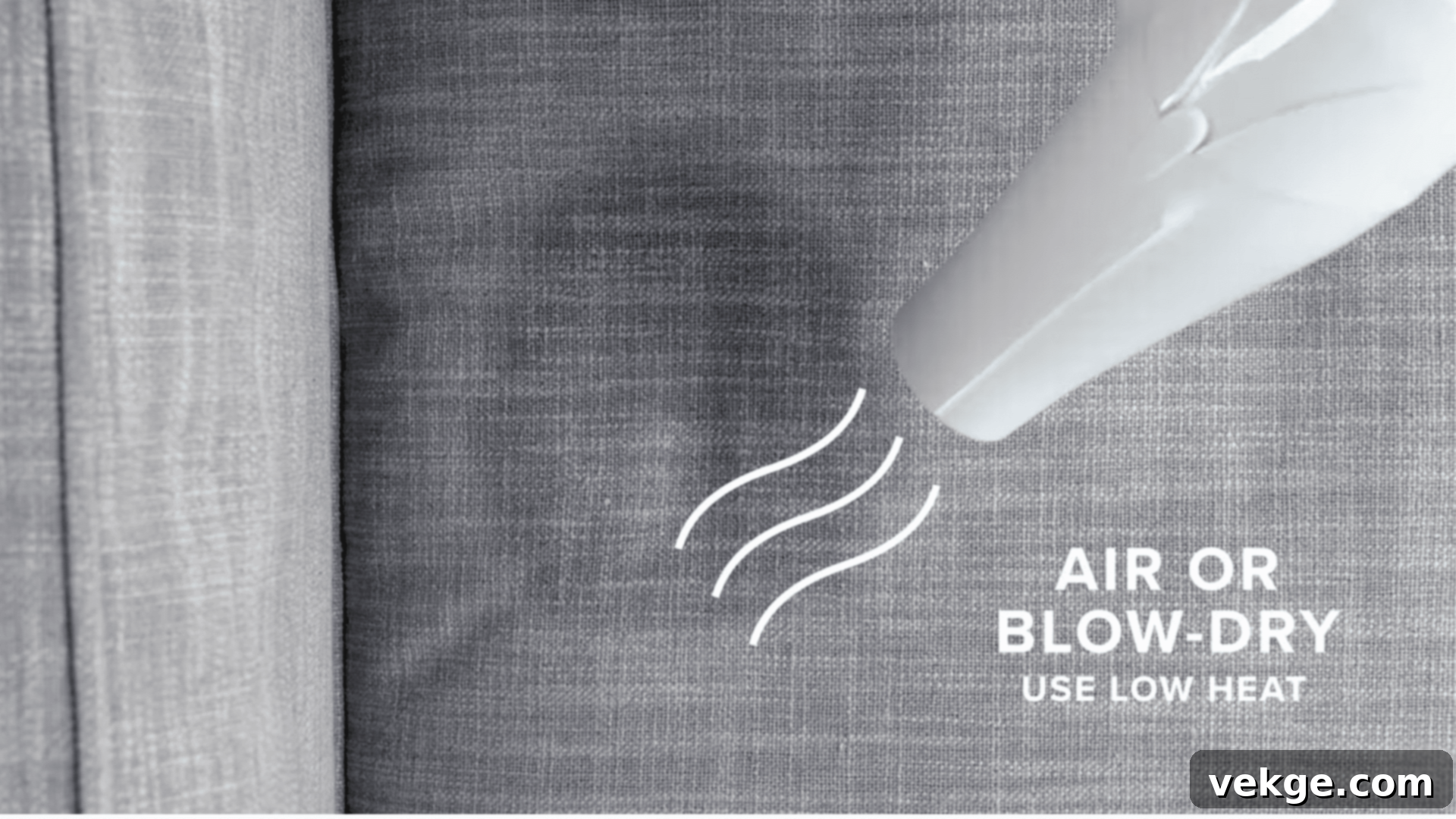
Proper drying is just as important as cleaning. Insufficient drying can lead to mildew, mold growth, unpleasant odors, and water rings. It’s crucial to ensure the couch is completely dry before use.
- Air dry naturally: After spot cleaning, the best method is to let the couch air dry naturally. This is the gentlest way to dry and minimizes the risk of heat damage.
- Maximize air circulation: To speed up the natural drying process, open windows wide to allow for cross-ventilation. Use fans (box fans, oscillating fans) directed towards the damp areas of the couch to increase airflow. A dehumidifier in the room can also be highly effective at drawing moisture out of the air and the fabric.
- Use a hair dryer (with caution): If you need to dry a specific, small, damp spot quickly, you can use a hair dryer. However, it’s vital to use it on its coolest setting only and keep it moving constantly. Concentrating heat in one spot can potentially damage or scorch the fabric.
- Check for complete dryness: Before allowing anyone to sit on or use the couch again, ensure it is absolutely, 100% dry to the touch, not just on the surface but deep into the upholstery. This might take several hours or even overnight, depending on humidity levels and the amount of moisture used.
Step 4: Avoid Machine Washing Cushion Covers (Unless Specified)

It’s a common misconception that if a cushion cover is removable, it’s safe for machine washing. This is often not the case and can lead to irreversible damage.
- Always re-check the care labels on your cushion covers before attempting to remove them or put them in a washing machine.
- Even if cushion covers are removable, do not put them in a washing machine unless the label explicitly states that machine washing is permitted and specifies the appropriate temperature and cycle.
- Why to avoid machine washing: Machine washing can be very harsh on upholstery fabrics. It can cause significant shrinkage, distort the shape of the cover, lead to color fading or bleeding, and even damage the fabric fibers, making them look worn or pilled. The covers might also become impossible to put back on the cushions properly.
- Alternatives for extra cleaning: If your cushion covers need more than spot cleaning, and machine washing isn’t an option:
- Consider professional dry cleaning. They have specialized equipment and solvents for delicate upholstery.
- You can try a gentle hand wash in a tub with appropriate detergent, but only if the care label suggests hand washing. Even then, proceed with extreme caution and test first.
- For general freshening, thorough vacuuming and deodorizing with baking soda can often suffice.
Remember, always test any cleaning method on a small, hidden area first to ensure it won’t damage or discolor your couch. Take your time with each step for the best possible results and a beautifully clean couch.
For more detailed information and visual guides on couch cleaning techniques, you might find this video helpful: click here.
Other Effective Methods to Clean a Fabric Couch
Beyond the fundamental steps of vacuuming and spot cleaning, there are several specialized methods you can employ to achieve an even deeper clean, tackle specific issues, or address different fabric types. This section explores five distinct techniques, each suited for particular cleaning needs. Always remember to consult your couch’s care label and perform a patch test on an inconspicuous area before applying any new cleaning method to your entire couch.
Method 1: Steam Cleaning for Deep Dirt
Steam cleaning is an excellent option for deeply embedded dirt and sanitization, as the hot vapor helps loosen grime and kill bacteria.
When to Use:
- Best for fabric couches that can tolerate heat and moisture (typically W or WS codes).
- Ideal for comprehensive cleaning, refreshing, and sanitizing.
- Always double-check the care label – avoid steam cleaning ‘S’ or ‘X’ coded fabrics.
How to Steam Clean:
- First, thoroughly vacuum the entire couch as outlined in Step 1.
- Fill your steam cleaner (or carpet/upholstery cleaner with a hand attachment) with clean water according to the manufacturer’s instructions, and allow it to heat up completely.
- Using the upholstery attachment, gently work on one small section of the fabric at a time. Move the attachment slowly to allow the steam to penetrate and lift dirt.
- Avoid saturating the fabric. The goal is to use just enough moisture to clean, not soak. Some machines have a vacuum function to extract excess moisture immediately.
- Overlap your strokes slightly to ensure even cleaning.
- Once cleaned, ensure adequate air circulation (open windows, use fans) to help the couch air dry fully before use. This can take several hours.
Method 2: Baking Soda for Odor Neutralization
Baking soda is a natural, non-toxic, and incredibly effective deodorizer that can refresh your couch without any harsh chemicals.
When to Use:
- Perfect for removing general odors, pet smells, stale air odors, or just freshening up a couch between deep cleans.
- Safe for virtually all fabric types, as it’s a dry application.
How to Apply:
- Thoroughly vacuum the couch first to remove any loose debris.
- Generously sprinkle a layer of plain baking soda over the entire fabric surface of the couch, including cushions. Don’t be shy; aim for a light, even coating.
- Allow the baking soda to sit and work its magic for at least 15-30 minutes. For stronger, more persistent odors (like pet urine or smoke), leave it on for several hours, or even overnight. The longer it sits, the more odors it will absorb.
- After the waiting period, use your vacuum cleaner with a brush attachment to thoroughly vacuum up all the baking soda. Ensure no residue is left behind.
- Repeat the process if necessary for a truly fresh and odor-free couch. You can also mix a few drops of essential oil (like lavender or tea tree) with the baking soda before sprinkling for an added fresh scent.
Method 3: Vinegar and Water Solution for Stains and Pet Odors
White vinegar is a powerful natural cleaner and deodorizer, particularly effective against acidic stains and pet odors due to its mild acidic properties.
When to Use:
- Ideal for spot cleaning stubborn stains and neutralizing strong odors, especially pet accidents.
- Generally good for most synthetic fabrics (W or WS codes) that can handle water-based solutions. Always test first, as it can be too strong for delicate natural fibers like silk or wool.
How to Use:
- In a spray bottle, mix equal parts white distilled vinegar and clean water. For tougher stains, you can use a slightly higher vinegar concentration (e.g., 2 parts vinegar to 1 part water).
- Lightly mist the stained or odorous area with the solution. Do not saturate the fabric.
- Immediately dab the area with a clean, lint-free cloth, working from the outside of the stain inwards.
- After the stain is lifted, dampen another clean cloth with plain water and dab the area again to “rinse” and remove any lingering vinegar smell or residue.
- Finally, dab the area thoroughly with a dry cloth to absorb excess moisture.
- Let the couch air dry completely, or use a hair dryer on a cool setting to speed up drying. The vinegar smell will dissipate as it dries.
Method 4: Dry Cleaning Solvent for “S” Coded Fabrics
For fabrics marked with an “S” care code, water is detrimental, and a dry cleaning solvent is the only safe option.
When to Use:
- Exclusively for fabrics with an ‘S’ care code, which cannot tolerate water-based cleaning solutions.
- Effective for removing grease, oil, and other non-water-soluble stains.
How to Apply:
- Purchase a fabric-safe dry cleaning solvent specifically designed for upholstery (read the product label carefully and ensure it’s compatible with your couch’s ‘S’ code).
- Always perform a patch test on a hidden area first, as solvents can react differently with various synthetic fibers.
- Ensure the room is well-ventilated by opening windows or using fans, as solvents can emit strong fumes.
- Apply a small amount of the dry cleaning solvent to a clean, white, soft cloth.
- Gently dab the stained area with the solvent-dampened cloth. Do not rub or saturate the fabric.
- Continue dabbing with a clean part of the cloth until the stain lifts.
- Allow the couch to air dry naturally. No rinsing is required with dry cleaning solvents.
Method 5: Using a Commercial Fabric Cleaner
Commercial fabric cleaners are formulated to tackle a range of stains and provide a deeper clean for various fabric types.
When to Use:
- For couches that need a deeper clean beyond simple spot treatment or general deodorizing.
- When dealing with stubborn, unidentified stains or overall dinginess that household remedies can’t handle.
- Always match the cleaner to your fabric’s care code (e.g., water-based for ‘W’, solvent for ‘S’).
How to Apply:
- Before anything else, carefully read and follow the manufacturer’s instructions on the product label.
- Always test the cleaner on a small, hidden section of your couch to check for any adverse reactions, discoloration, or damage.
- Apply the cleaner according to the product’s directions. This usually involves spraying a small amount directly onto the stained area or applying it to a cloth first.
- Gently dab (don’t scrub) the area with a clean, soft cloth. Some cleaners require a light brushing action; refer to the product instructions.
- If rinsing is required by the product, use a clean, damp cloth to wipe away residue.
- Let the couch air dry completely, or use a fan to speed up the drying process and prevent water marks.
Remember, the golden rule of upholstery cleaning is always to test any cleaning method on a small, hidden area first to make absolutely sure it’s safe for your specific couch fabric. Patience and caution are your best allies for a successful clean.
Quick Tips for Maintaining a Clean Couch Between Deep Cleans
Keeping your couch looking fresh and extending the time between deep cleaning sessions doesn’t have to be a monumental task. By incorporating a few simple habits into your routine, you can significantly prolong the life and appearance of your fabric couch. Here are some easy and effective ways to keep your couch looking good day-to-day:
1. Vacuum Regularly and Thoroughly:
- Make vacuuming your couch a weekly habit, similar to vacuuming your floors.
- Always use your vacuum’s soft brush attachment to prevent fabric damage.
- Pay extra attention to the cracks, crevices, and under the cushions where crumbs, dust, and pet hair are most likely to accumulate.
- Regular vacuuming prevents dirt from embedding deeply into the fabric, making future cleaning much easier.
2. Utilize Covers or Throws:
- Invest in washable couch covers or decorative throws. These are excellent protective barriers.
- They effectively catch spills, pet hair, and general dirt before these elements can reach and damage your couch fabric.
- Wash the covers and throws frequently to keep them (and your couch) smelling and looking fresh. This is much easier than cleaning the entire sofa.
3. Rotate Cushions Periodically:
- Every few weeks or once a month, make it a point to rotate your couch cushions. Flip them over and switch their positions (e.g., move a left cushion to the right).
- This simple practice helps the couch wear out more evenly, preventing one spot from getting disproportionately flattened or stained due to constant use.
- It also allows different parts of the cushions to be exposed to air, helping to minimize odor buildup.
4. Deal with Spills Immediately:
- The quicker you act on a spill, the less likely it is to become a permanent stain. Keep a clean, white, absorbent cloth (microfiber is great) readily available near your couch.
- As soon as a spill occurs, immediately blot (do not rub!) the liquid to absorb as much as possible.
- If necessary, follow up with a gentle spot clean using plain water or a mild soap solution, always testing first.
5. Brush Off Pet Hair Regularly:
- If you share your home with furry friends, pet hair can quickly become a major issue.
- Use a lint roller, a specialized pet hair remover tool, or even damp rubber gloves (rubbing your gloved hand over the fabric will ball up the hair) often.
- Regular removal of pet hair prevents it from weaving into the fabric fibers, which makes it much harder to remove later.
6. Air Out Your Couch:
- On pleasant, low-humidity days, open your windows and allow fresh air to circulate around your couch.
- This natural ventilation helps to dispel stale odors and keeps your upholstery smelling fresh without the need for artificial air fresheners.
- If possible, pull the couch slightly away from the wall to allow air to circulate around the back as well.
By consistently following these simple maintenance tips, you can significantly prolong the clean and fresh appearance of your couch, making deep cleaning a less frequent and less intensive undertaking. Your couch – and your living space – will look and feel much more inviting!
Common Mistakes to Avoid When Cleaning a Fabric Couch
While the goal is to refresh your fabric couch, making common mistakes during the cleaning process can lead to more harm than good, potentially damaging your furniture permanently. Being aware of these pitfalls can help you avoid costly errors and ensure a successful clean. Here are some of the most frequent errors and how to steer clear of them:
| Common Mistakes | Why It’s a Problem | What to Do Instead |
|---|---|---|
| Using Too Much Water or Over-saturating | Excess water can soak deep into the cushions and padding. This creates a breeding ground for mold and mildew, leads to unpleasant musty odors, and can cause permanent water stains or even structural damage to the couch’s frame. | Always use as little water or cleaning solution as possible. Focus on damp cleaning (using suds or a lightly misted spray) rather than soaking. Blot thoroughly to remove excess moisture immediately and ensure the area is completely dry afterward. |
| Scrubbing Stains Aggressively | Hard, vigorous scrubbing can severely damage the delicate fabric fibers, causing them to fray, pill, or stretch. It also tends to push the stain deeper into the fabric and spread it outwards, making it larger and harder to remove. | Always blot stains gently using a clean, soft, white cloth. Work from the outside edge of the stain towards the center to prevent spreading. Patience and repeated dabbing are more effective than harsh scrubbing. |
| Neglecting to Test Cleaning Products on a Hidden Area | Different fabrics react differently to cleaning agents. Some cleaners may cause discoloration, fading, fabric shrinkage, or permanent water rings on certain materials, leading to visible and irreversible damage. | This step is non-negotiable. Always test any new cleaner or homemade solution on a small, inconspicuous spot (e.g., the underside of a cushion or a hidden flap) first. Proceed with visible areas only if the test spot shows no adverse reactions after drying. |
| Ignoring Manufacturer’s Care Instructions (Care Tag) | Disregarding the care label’s specific instructions for your fabric type (W, S, WS, X codes) can lead to using the wrong type of cleaner (e.g., water on ‘S’ coded fabric). This can void your warranty, cause irreparable damage like water stains, shrinkage, or fabric degradation. | Always locate and carefully read your couch’s care tag before attempting any cleaning. Follow the manufacturer’s instructions meticulously. If you are unsure or the tag is missing, consult a professional upholstery cleaner to avoid risks. |
By being mindful of these common mistakes and adopting the correct techniques, you can clean your fabric couch safely and effectively, ensuring it remains in excellent condition and looking great for many years to come.
Conclusion: Reclaim Your Fresh and Clean Fabric Couch
Deep cleaning your fabric couch might initially seem like a formidable task, but as this guide has demonstrated, it doesn’t have to be daunting. With the detailed methods and practical tips we’ve shared, from meticulous vacuuming and targeted spot cleaning to specialized techniques like steam cleaning or baking soda deodorizing, you now possess the knowledge and confidence to transform your couch from tired to truly inviting.
Remember, while deep cleaning provides a significant refresh, consistent regular maintenance is the cornerstone of extending your couch’s life and upholding a healthy, hygienic living space. Simple habits like weekly vacuuming, immediate spill treatment, and cushion rotation can make a world of difference in the long run.
Always prioritize safety by checking your couch’s care label before introducing any new cleaning methods or products. This crucial step will prevent unintended damage. For particularly stubborn stains, delicate or unknown fabric types, or if you’re ever in doubt, never hesitate to seek the expertise of a professional upholstery cleaner. Their specialized tools and knowledge can often tackle what DIY methods cannot, without risking your furniture.
Now that you’re equipped with a comprehensive understanding of how to deep clean and maintain your fabric couch, why not put these tips into action today? Start with a quick vacuum to remove surface dust, or try the simple yet effective baking soda method to freshen up your living room’s centerpiece. Your revitalized couch – and your family – will undoubtedly thank you for the renewed comfort and cleanliness.
Have you tried any of these cleaning methods, or do you have a secret tip for keeping your couch spotless? Share your experiences and insights in the comments below! We’d love to hear from you.
Frequently Asked Questions About Fabric Couch Cleaning
Can I use dish soap to clean my fabric couch?
Yes, for many ‘W’ or ‘WS’ coded fabric couches, you can use a small amount of mild, clear, dye-free dish soap mixed with warm water. The key is to create suds and use only the suds on your cleaning cloth, not the liquid water itself, to avoid over-saturating the fabric. Always test this solution on a hidden area first to ensure it doesn’t cause discoloration or damage. Dab gently with the sudsy cloth, then follow with a clean, damp cloth to remove residue, and blot dry thoroughly.
How do I clean my couch without a steam cleaner?
A steam cleaner isn’t always necessary for a deep clean. You can achieve excellent results with these methods: First, vacuum your couch thoroughly with an upholstery attachment to remove all loose dirt. For specific stains, spot clean using a mixture of mild dish soap and water (suds only) or a vinegar and water solution (for pet stains and odors). To effectively remove odors, sprinkle a generous amount of baking soda over the entire couch, let it sit for several hours (or overnight for strong smells), then vacuum it up completely. For ‘S’ coded fabrics, a dry cleaning solvent can be used. Always ensure the couch dries completely to prevent mold and mildew.
Is it safe to use vinegar on all fabric types?
No, vinegar is not safe for all fabric types. While it’s generally safe and very effective for most durable synthetic fabrics (polyester, microfiber) that have ‘W’ or ‘WS’ care codes, its acidic nature can be detrimental to delicate natural fibers such as silk, wool, rayon, or linen. It can cause discoloration, damage the fibers, or leave water marks. Always, always check your couch’s care label first, and even then, perform a patch test on an inconspicuous area before applying vinegar to a visible section of your couch.
How can I remove odors from my couch effectively?
The most effective and natural way to remove odors from your couch is by using baking soda. Start by thoroughly vacuuming the couch. Then, generously sprinkle a layer of baking soda over the entire fabric surface. Allow it to sit for at least 30 minutes, or for more pervasive odors, leave it overnight (6-8 hours). The baking soda will absorb and neutralize the smells. After the waiting period, vacuum up all the baking soda completely. For persistent smells, you can repeat this process. Additionally, ensuring good air circulation by opening windows can help dissipate odors naturally, and a mixture of equal parts white vinegar and water can be used on ‘W’ or ‘WS’ coded fabrics for particularly strong pet odors, always with a prior patch test.
How often should I deep clean my fabric couch?
The frequency of deep cleaning depends on several factors: how often the couch is used, if you have pets or children, and your lifestyle. As a general guideline, it’s recommended to deep clean your fabric couch every 6 to 12 months. However, if you have pets, young children, frequently host guests, or notice significant spills and odors, you might want to deep clean every 3-6 months. Regular maintenance, such as weekly vacuuming and immediate spot treatment, can significantly extend the time needed between deep cleans.
